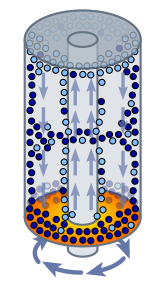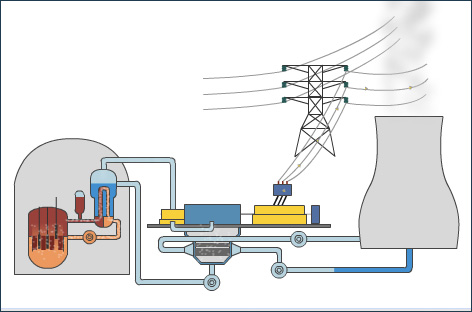(nuclear power)
Nuclear electricity - production of electrical energy from uranium (nuclear fission and accelerated neutron bombardment) in a nuclear power plant
Researcher and author: Dr. ( Afshin Rashid)
Note: In practice, the nucleus of a heavy element, for example 235U, is bombarded by accelerated neutrons, in this case, one Mev of binding energy is released for each uranium nucleon. Now, if this reaction is carried out on one kilo of 235U, the energy obtained will be equivalent to 106 x 20 kwH. If we want to obtain this amount of energy from fossil fuels, the amount of 1.7 million liters with 2.5 million kilos of coal is needed. we have.
In the enrichment section, uranium is enriched to about 4-5%. Because this percentage will be enough to produce energy. (Peaceful Energy) Because the chemical properties of uranium 238 and 235 are the same, we cannot separate them through chemical processes. But because uranium 238 is heavier than uranium 235. We use this property to separate these two types of uranium.
Uranium 235 is fissile and 238 is not. Uranium 235 decays spontaneously but has a long life (one million years). If the percentage of uranium 235 exceeds a certain limit, there is a possibility of a chain reaction. One out of every three released neutrons is consumed. And two more neutrons are released, which are used for subsequent reactions. Again, six neutrons are produced, two neutrons are used and the other four neutrons are used for other reactions and so on.
The general form of electric energy production in nuclear power plants is the same as in thermal power plants, with the difference that the source of heat production is not fossil fuel, and the energy required to produce steam to turn the turbine is obtained from atomic interactions in the reactor.Usually, the energy resulting from atomic interactions in the reactor is transferred to a fluid, which can be directed directly to the turbine or heat another fluid by passing through the heat exchanger and finally turn the necessary water into steam and use it. direct to the turbine. In the early nuclear reactors, the primary conveying fluid was water, which was directly directed to the turbine after turning into steam, but in today's technology, to enable more control over atomic interactions and reduce the risks caused by interactions In a closed circuit, the intermediate fluid transfers the heat produced in the reactor to water in a separate heat exchanger and turns it into steam.
Conclusion :
In practice, the nucleus of a heavy element, for example 235U, is bombarded by accelerated neutrons, in this case, one Mev of binding energy is released for each uranium nucleon. Now, if this reaction is carried out on one kilo of 235U, the energy obtained will be equivalent to 106 x 20 kwH. If we want to obtain this amount of energy from fossil fuels, the amount of 1.7 million liters with 2.5 million kilos of coal is needed. we have.
Researcher and author: Dr. ( Afshin Rashid)
Specialized doctorate in nano-microelectronics





